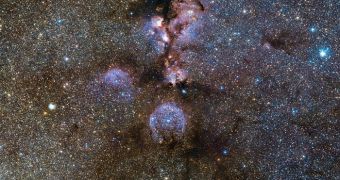Scientists at the European Southern Observatory (ESO) have just released a new impressive image of the Cat's Paw Nebula, an area of intense stellar formation in the constellation Scorpius. The photograph reveals the presence of hundreds of forming massive stars within the large gas and dust clouds of the nebula, also called a stellar nursery. Famous astronomer John Herschel, for whom the new ESA telescope is named, first observed the Cat's Paw Nebula (NGC 6334), back in 1837, Space reports.
A stellar nursery is an area of space that features impressively-large clouds of cosmic dust and very cold hydrogen gas. As regions of these clouds clump together, they eventually grow out of control, until they reach a threshold. Once this happens, the clouds implode and fall in on themselves, igniting in the process. If the amount of gas is sufficiently large to sustain nuclear fusion of hydrogen atoms, then a new star is born. If ignition fails to take place, the result is a brown dwarf, an object classified somewhere between small stars and gas giant planets.
The Cat's Paw Nebula has a diameter of around 50 light-years, and is located towards the center of our galaxy, the Milky Way. Astronomers have calculated that the structure is some 5,500 light-years away from Earth. The new image was snapped using the largest infrared camera of any ground-based telescopes, the VISTA instrument. It is located at the Paranal Observatory, in the Atacama Desert of Chile. The location is extremely suitable for astronomical observations, as it has barely any clouds above, and the night sky is very dark.
The reason why the observations were conducted in infrared wavelengths is because visible light cannot readily penetrate the thick layer of clouds that envelop the active star-forming region of the nebula. The only thing visible in this portion of the electromagnetic spectrum is the haze that massive stars within the stellar nursery impart on the entire structure. However, VISTA's keen eye managed to penetrate that entire material, and provide us with a view of what's going on inside. Astronomers were thus able to determine that some of the stars within are up to ten times more massive than our own Sun.

 14 DAY TRIAL //
14 DAY TRIAL //